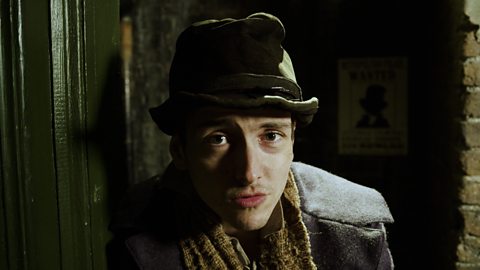DODGER:
Oi, Morgan!
MORGAN:
Watch your step!
DODGER:
I've got a question for you. What's it like in a workhouse?
MORGAN:
I'll tell you. Yeah, for a penny.
The workhouse is the last place you want to go. They deliberately make it bad. Bad food, bad clothes, bad beds.
POLLY:
What, worse than the streets?
MORGAN:
I'll tell ya, for a penny.
In a way, yeah. Although it actually has saved a lot of people from starvation. Old people can't work anymore, little kids, unfortunate people who lost their jobs.
DODGER:
Yeah but what you do in the workhouse?
MORGAN:
I'll tell ya.
DODGER:
Na.
MORGAN:
For a penny.
DODGER:
No.
MORGAN:
Any time today.
Well, work of course! We start at six oβclock in the morning until eight at night, no fire to keep you warm.
TANG:
What sort of work?
MORGAN:
I'll tell ya, for a penny.
POLLY:
You're taking the mick you are!
MORGAN:
Well, a fellaβs got to earn for a living.
Women do cooking, laundry, sewing. Men do bone-crushing, stone-breaking and oakum-picking.
DODGER:
Whatβs oakum?
MORGAN:
I'll tell ya, for a penny.
DODGER:
Oh, thatβs too much now.
POLLY:
Come on.
DODGER:
I am doing it. Well, whatβs oakum?
MORGAN:
Oh I donβt know.
DODGER:
Give me my penny back.
POLLY:
Oh I know what oakum is, itβs rope. Pull apart old rope from the shipyard. Makes your hands bleed itβs that rough.
CHARLEY:
Once it's pulled apart the workhouse sends it back to the old shipyard, money for old rope.
MORGAN:
You know what, I'll tell you this much for free. Some people would rather go to prison than the workhouses.
TANG:
Why is that?
POLLY:
No, not this again.
MORGAN:
If you have a mum and dad, youβd only be able to see them for a few minutes of the day and you have to take a regular bath!
DODGER:
Oh, I'm not going there then!
MORGAN:
No, this is a miserable, miserable time to be poor.
DODGER:
When is it ever a good time to be poor?
MORGAN:
True, very true.
POLLY:
But the thing is, when you're poor, you get diseases.
CHARLEY:
Yeah, but the rich get diseases too.
DODGER:
Well, rich and poor getβ¦
TANG:
Smallpox.
POLLY:
Typhoid.
CHARLEY:
Consumption, you call it tuberculosis.
MORGAN:
And the little kiddies, in particular, they catch measles.
DODGER:
Mumps.
CHARLEY:
Diphtheria.
POLLY:
Whooping cough.
TANG:
Scarlet fever.
MORGAN:
And rubella.
A man called Edwin Chadwick looked at how long people lived and where they lived.
TANG:
He looked at what job they did too.
POLLY:
He found out that tradesmen and labourers had shorter lives.
DODGER:
And people living in the country lived longer than people living in the city.
CHARLEY:
I knew I should have never left the countryside!
DODGER:
Speaking of cities, an epidemic swept through London.
MORGAN:
Two.
CHARLEY:
Three.
POLLY:
Four times.
DODGER:
It was terrifying.
MORGAN:
Us poor in the slums suffered the most.
POLLY:
We were all crowded in together see.
CHARLEY:
Symptoms were diarrhoeaβ¦
DODGER:
Nausea.
TANG:
Puking.
POLLY:
Sunken eyes.
CHARLEY:
And shriveled blue skin.
MORGAN:
They called it the blue death.
TANG:
And once you caught it, you could die within hours.
POLLY:
Us poor you see, we live in filth.
DODGER:
There were courtyards full of bum leavings.
CHARLEY:
It all overflows from cesspits in basements.
MORGAN:
Into the gutters in the waterways.
TANG:
Then we drink that water.
CHARLEY:
During our time, everyone thought disease was caused by bad air.
POLLY:
Miasma they called it.
DODGER:
A geezer called John Snow noticed that most people were dying from the blue death by drinking from the same water pump in Broad Street, in Soho, in London.
MORGAN:
He found a leaking sewer right near the well.
DODGER:
He proved that clean water was the answer. It took a while, but eventually, cholera went bye bye.
POLLY:
Thanks, John Snow.
GROUP:
Yeah, thanks John Snow.
DODGER:
I didn't really fancy going blue. Ainβt really my colour.
Video summary
In this short film for primary schools Dodger and the gang provide a brief guide to the Victorian workhouse and the common diseases from the time, particularly cholera.
In the film, cholera is not mentioned by name but is referred to as βthe blue deathβ. It was given this nickname as a person's skin may turn bluish-grey, the reason being that a person may lose nearly half their bodily fluids within 24 hours, and this high dehydration turns the skin blue.
The short film is from the ΒιΆΉΤΌΕΔ Teach series Dodger's Guide to Victorian Britain.
Teacher Notes
Before watching the film
There are two potential lines of enquiry which could emerge from this video and although the pupils will gain much from the whole video, in the classroom it will be worth focusing on either the workhouse or health, or both if you have the time for two separate lessons.
To cover both at the same time may give the pupils the false impression that the diseases mentioned in the video only affected the poor: as Charley says βthe rich people get 'em tooβ. However, it is true that the dreadful overcrowded living conditions did mean that the spread of infectious diseases was greater amongst the poor.
Questions to consider whilst watching the film
Depending on the focus of your lesson, you may wish to pause the short film at certain points to check for understanding, asking questions such as:
- In what ways was life in the workhouse bad?
- Why do you think life was made deliberately bad in the workhouse?
- Why do you think it was called a workhouse?
- What do you think was meant by βdeserving poorβ? Who might be βundeservingβ?
- What were the common diseases in Victorian times and why are they no longer common today?
- What were the symptoms of cholera?
- At the time what did people think was the cause of cholera? What are the actual causes of the disease?
- Why are there no outbreaks of cholera today in this country?
After watching the film - activities to further explore learning
Focus 1: The Workhouse
- Historical enquiry - Pupils need to be encouraged to study a range of sources and ask and answer questions about them.
The class could take part in a class investigation of the workhouse by firstly, considering what do the pupils want to know about the workhouse. Depending on the class, you may wish to model a set of questions, or you may want them to work in small groups devising their own questions. Then provide each group with a different image and the children have to answer their questions based solely on what they can see in front of them. A key learning point here is that one source cannot answer all your questions and so it will be important in a whole class plenary to pool together what they have learnt from the pictures.
In the later Victorian period, it was possible to be admitted to the workhouse temporarily for a night. There is a vivid and moving painting of this from 1874 by the British painter Luke Fildes, entitled Applicants for Admission to a Casual Ward. By close study of the painting, it is possible to identify some of the reasons why people were poor: for example, old age, a large family or a disability.
There are a number of approaches to take; one is a jigsaw approach, in which the picture is treated as a mystery and the children just see one part of the picture and have to study it and then speculate what might be in the rest of the image. A variant on this is the reveal where the teacher starts at the right or left of the picture and reveals the next section until the whole painting is visible.
Images such as this could be used as a stimulus for a freeze frame activity where the children recreate characters in the image and begin to empathise with the reasons why they wish to enter the workhouse.
Focus 2: Public Health and Disease
Historical enquiry - The video makes reference to the work of John Snow in identifying the true source of the cholera outbreak in 1854. . A teacher will need to be selective but in following up on this video, there are some visual sources about Snow and the Broad Street pump.
Concept of similarity and difference - It is important in history to encourage pupils not to make assumptions that life was the same for all Victorians. Life would be different dependent on factors such as where you lived and what was your social class. In 1842, Chadwick's report, 'The Sanitary Condition of the Labouring Population', was published. The report showed a link between poor living conditions and poor health. One of the famous conclusions to emerge was the effect of poor living conditions on life expectancy:
| Average Age of Death in 1842 | ||
|---|---|---|
| Place | Rich | Poor |
| Manchester (an example of a city) | 38 | 17 |
| Wiltshire (an example of the countryside) | 50 | 33 |
Μύ
These figures can be used in mathematics to explore averages, so as to address the common misconception that poor city dwellers did not live beyond their teenage years.
In history, this can be used to explore the concept of similarity and difference. One of the main reason for the low figure for the Manchester poor would be a high infant mortality rate; this can a very useful stimulus for classroom discussion about how many of the children were born in hospital and why this happens in the 21st century.
England
From the History national curriculum:Pupils should:
- understand historical concepts such as similarity, difference.
- understand the methods of historical enquiry, including how evidence is used rigorously to make historical claims.
Northern Ireland
From the statutory requirements for Key Stage 2: The World Around UsPupils should be enabled to explore:
- Change over time in places.
To provide a balance of experiences in history pupils could study:
- Some of the characteristics of past societies and distinctive features of life in the past.
Teaching should provide opportunities for children as they move through Key Stages 1 and 2 to progress:
- from identifying similarities and differences to investigating similarities and differences, patterns and change.
Scotland
From the Experiences and Outcomes for planning learning, teaching and assessment of Second Level Social Studies
- I can use primary and secondary sources selectively to research events in the past.
- I can investigate a Scottish historical theme to discover how past events or the actions of individuals or groups have shaped Scottish society.
Wales
From the new Humanities Area of Learning and ExperienceSchool curriculum design for History should:
- develop historical β¦ source-based skills.
- develop rich content across the time periods, through which learners can develop an understanding of chronology through exploring β¦ similarity and differenceβ¦the use of evidence.
- expose learners of all ages to a range of historical periods on a local, national and global scale.
Principles of progression
Descriptions of learning for Progression Step 2
Enquiry, exploration and investigation inspire curiosity about the world, its past, present and future:
- I have been curious and made suggestions for possible enquiries and have asked and responded to a range of questions during an enquiry.
- I have experienced a range of stimuli, and had opportunities to participate in enquiries, both collaboratively and with growing independence.
- I can collect and record information and data from given sources. I can then sort and group my findings using different criteria.
Human societies are complex and diverse, and shaped by human actions and beliefs:
- I can recognise similarities and differences between peopleβs lives, both in the past and present.
- I can identify aspects of life in my community that have changed over time.
Dodger's guide to being a Victorian kid. video
In this short film for primary schools Dodger and the gang provide a brief guide to life for children in Victorian Britain, including some of the ways in which children were employed.

Dodger's guide to key inventions. video
In this short film for primary schools Dodger and the gang provide a guide to those inventions from the Victorian era which changed lives then and now.

Dodger's guide to Victorian London. video
In this short film for primary schools Dodger and the gang provide an introduction to Victorian London which was, at that time, the biggest city in the world.

Dodger's guide to crime and punishment. video
In this short film for primary schools Dodger and the gang provide a brief guide to crime and punishment in Victorian Britain.
